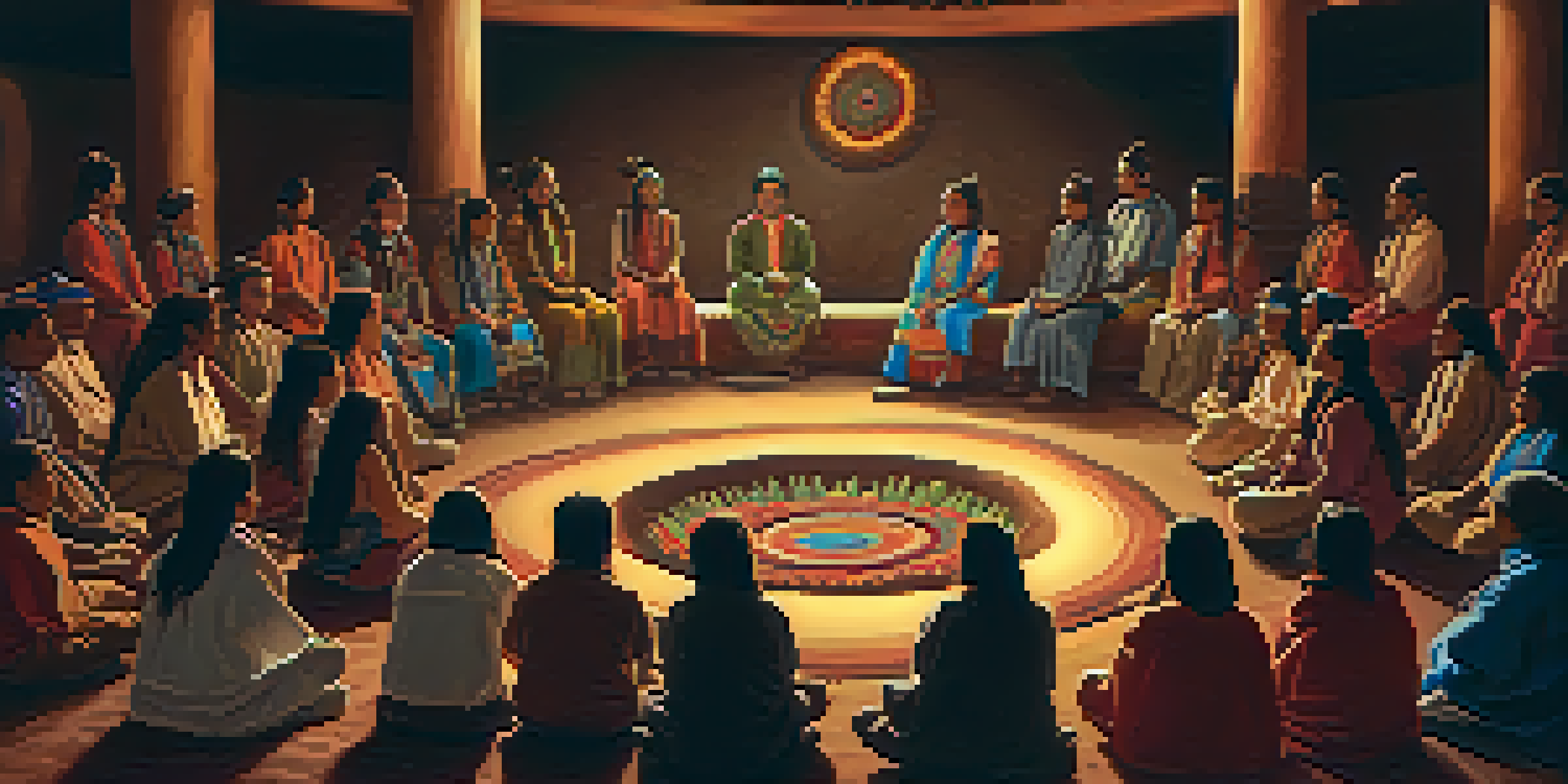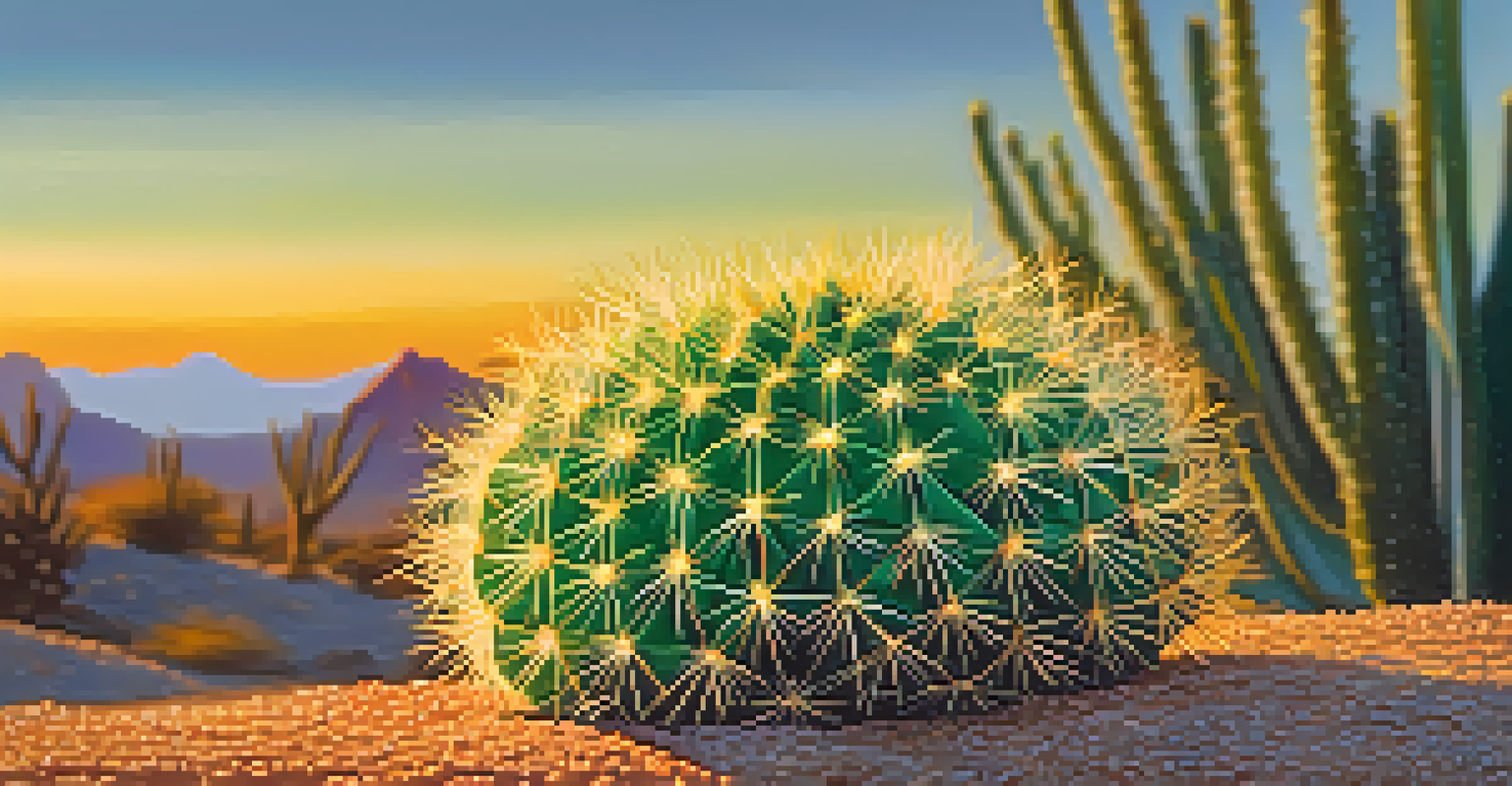Peyote Ceremonies: Building Community Identity in Tribes

Understanding Peyote and Its Cultural Significance
Peyote, a small cactus native to Mexico, has been used for centuries in spiritual practices by Indigenous tribes. Its psychoactive properties, primarily from the compound mescaline, facilitate deep introspection and connection to the spiritual world. This unique plant is more than just a substance; it’s a sacred tool that plays a central role in various tribal traditions, particularly within the Native American Church.
Peyote is a sacred medicine, a bridge to the divine that connects us to our ancestors and to one another.
The significance of peyote goes beyond its hallucinogenic effects; it’s a symbol of identity and resilience for many tribes. By incorporating peyote into their rituals, these communities affirm their cultural heritage and fight against historical oppression. The ceremonies surrounding peyote use are not just about the experience itself but also about preserving and honoring ancestral traditions.
In these contexts, peyote becomes a bridge that connects individuals to their ancestors and to one another. Through shared experiences in peyote ceremonies, participants reinforce their community bonds, creating a sense of belonging and collective identity. This interconnectedness is crucial, especially in times when Indigenous identities face external pressures.
The Structure of Peyote Ceremonies
Peyote ceremonies typically involve a series of rituals that can last for several days, bringing together community members in a sacred space. The ceremony is often led by a spiritual leader or shaman who guides participants through the process, ensuring that the experience remains respectful and meaningful. This structure not only provides a framework for the spiritual journey but also fosters a sense of safety and support within the group.

During the ceremony, participants engage in singing, drumming, and prayer, all of which enhance the communal atmosphere. The act of sharing these rituals helps solidify relationships among tribe members, highlighting the importance of unity in their spiritual practices. Each individual contributes to the collective experience, reinforcing the idea that spirituality is a shared journey.
Peyote's Cultural Importance
Peyote serves as a sacred tool for Indigenous tribes, facilitating spiritual connection and cultural resilience.
Additionally, the ceremonial use of peyote often coincides with storytelling and sharing of personal experiences. This creates an environment where community members feel valued and heard, further enhancing their identity as part of a larger whole. The rituals are not just about individual enlightenment; they are about cultivating a strong, interconnected community.
Healing and Transformation Through Peyote Use
Many participants in peyote ceremonies report profound personal healing and transformation. The insights gained during these experiences can lead to significant changes in one’s life perspective, promoting emotional and psychological well-being. For many Indigenous people, these ceremonies act as a form of therapy, helping them navigate the challenges faced within their communities and the broader society.
In every community, there is work to be done. In every nation, there are wounds to heal. In every heart, there is the power to do it.
The process of healing in this context is deeply intertwined with the community. As individuals confront their personal struggles, they often find support from fellow participants who can relate to their experiences. This shared vulnerability fosters a culture of empathy and understanding, essential elements in building a resilient community identity.
Moreover, the healing that occurs during peyote ceremonies often extends beyond the individual. When one person transforms, it can have a ripple effect, inspiring others to embark on their own journeys of healing and self-discovery. This interconnected healing process strengthens community ties and reinforces the collective identity of the tribe.
Youth Engagement in Peyote Ceremonies
Involving youth in peyote ceremonies is crucial for the continuity of cultural practices and community identity. By participating in these sacred rituals, younger generations learn about their heritage and the values that underpin their community. This engagement helps instill a sense of pride and belonging, vital for maintaining cultural traditions.
Youth participation also fosters intergenerational dialogue, where elders share wisdom and guidance with younger tribe members. This exchange not only enhances the youth's understanding of their culture but also strengthens the bonds between generations. As young people learn the significance of peyote and its ceremonies, they become active stewards of their cultural identity.
Healing Through Community Rituals
Ceremonies involving peyote foster personal healing and strengthen community ties through shared experiences.
Furthermore, these experiences empower youth to address contemporary challenges within their communities. Armed with a strong sense of identity and connection to their roots, they are better equipped to advocate for their communities and navigate the complexities of modern life. Engaging youth in peyote ceremonies ultimately ensures the survival and thriving of tribal identities for future generations.
Challenges Facing Peyote Ceremonies Today
Despite their significance, peyote ceremonies face numerous challenges in today's society. Legal restrictions surrounding the use of peyote can pose significant obstacles for tribes wishing to practice their traditions. This often leads to frustration and a sense of disconnection from their cultural roots, highlighting the need for greater understanding and respect for Indigenous practices.
Additionally, environmental issues threaten the natural habitats where peyote grows. Overharvesting and habitat destruction can lead to a decline in peyote availability, impacting the rituals that rely on this sacred plant. This situation not only affects the spiritual practices of tribes but also emphasizes the importance of environmental stewardship within Indigenous communities.
The ongoing struggle for recognition and respect for Indigenous rights also complicates the practice of peyote ceremonies. Many tribes are advocating for their rights to practice their spirituality openly and without restriction. Addressing these challenges is crucial for the continuity of peyote traditions and the preservation of tribal identity.
The Role of Peyote in Cultural Revitalization
Peyote ceremonies are pivotal in the broader movement of cultural revitalization among Indigenous tribes. By reclaiming their traditional practices, communities can strengthen their cultural identity and assert their place in today’s society. The act of coming together for peyote ceremonies is a statement of resilience and a commitment to honoring their heritage.
Cultural revitalization through peyote practices often involves educating both community members and outsiders about its significance. This not only dispels misconceptions but also fosters a greater appreciation for Indigenous cultures. By sharing their stories and experiences, tribes can bridge the gap between their traditions and the modern world.
Youth Engagement is Vital
Involving youth in peyote ceremonies ensures the continuity of cultural practices and empowers them to advocate for their communities.
Moreover, revitalizing these ceremonies encourages the younger generation to take pride in their heritage. As they engage with peyote traditions, they become more connected to their community and its history. This sense of pride and ownership is crucial for the survival of Indigenous cultures and identities in a rapidly changing world.
Peyote Ceremonies as a Path to Unity
Ultimately, peyote ceremonies serve as a powerful path to unity within tribes. They create a safe space where individuals can come together, share their experiences, and support one another. The collective nature of these ceremonies fosters a sense of belonging that is essential for maintaining a strong community identity.
Through shared rituals and experiences, participants build lasting connections that transcend individual differences. This unity is vital for tribes, especially in the face of external challenges and pressures. By coming together in the spirit of healing and transformation, communities reinforce their shared identity and collective strength.

In this way, peyote ceremonies not only nurture spiritual growth but also cultivate a sense of solidarity among tribe members. They remind participants of their shared history, values, and aspirations, ensuring that the community remains resilient and cohesive. As tribes continue to navigate the complexities of modern life, the importance of these ceremonies as a unifying force cannot be overstated.